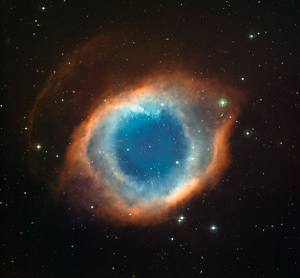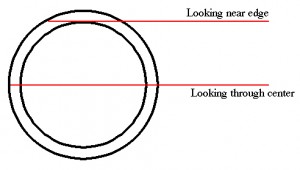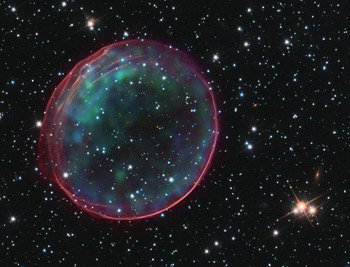One of my favorite types of objects in space are the thin, ethereal shells of gas stars create when they die. So I was thrilled* to see this new image of one taken in exquisite detail by the Hubble Space Telescope:
[Click to supernovenate.]
I studied weird soap bubbles like this for quite some time for both my post-graduate degrees, and they still fascinate me. This one, called SNR 0509, is actually a very interesting example. There are lots of ring-shaped objects in the sky – the Helix nebula (seen below) may be the most canonical – but usually the ring itself is thick, the width of the band being a large fraction of the object diameter itself. Why does SNR 0509 have such a thin ring?
 I’m glad you asked! OK, so I asked, but if I were you I would’ve asked that. And I’m me and I did.
I’m glad you asked! OK, so I asked, but if I were you I would’ve asked that. And I’m me and I did.
First off, we need to understand what happened here to form the object in the first place. When a relatively low-mass star like the Sun dies, it blows off a steady wind of subatomic particles, like the solar wind but much thicker. The physics is a bit complex, but basically as the star gets older that wind speeds up. The faster particles slam into the slower ones, and light up. You get what’s called a planetary nebula, like the Helix (pictured here on the right; click it to get a really big pretty version of it).
 In many cases, the reason we see a ring is because of an effect called limb-brightening. If the star’s wind were steady, it would form a big, spherical nebula around the star. But the faster wind wind plows up material, hollowing out the sphere, forming a shell. The gas glows, and this makes it look like a soap bubble in space, because we see more gas near the edge than through the center – I drew the diagram here to show that (click it to make it bigger). Imagine you are off to the right, looking at a spherical shell of gas to the left. When you look through the center, you’re not seeing as much gas as you do near the edge. Since it’s the gas that’s glowing, the more you see, the brighter it gets. So the nebula is brighter in a circle around the edge (near the limb), and darker in the middle. A ring!
In many cases, the reason we see a ring is because of an effect called limb-brightening. If the star’s wind were steady, it would form a big, spherical nebula around the star. But the faster wind wind plows up material, hollowing out the sphere, forming a shell. The gas glows, and this makes it look like a soap bubble in space, because we see more gas near the edge than through the center – I drew the diagram here to show that (click it to make it bigger). Imagine you are off to the right, looking at a spherical shell of gas to the left. When you look through the center, you’re not seeing as much gas as you do near the edge. Since it’s the gas that’s glowing, the more you see, the brighter it gets. So the nebula is brighter in a circle around the edge (near the limb), and darker in the middle. A ring!
Oh– it’s important to know that the gas is transparent. If it were opaque, like a solid wall, you’d see a disk, and not a ring. So light passes right through this gas (you can see stars through it). That means that it doesn’t matter if an atom of gas is on the near side or far side of the shell; if it emits light, you’ll see it. It also doesn’t matter from what direction you look: since it’s a spherical shell, it looks like a ring no matter where you are!
The thing is, while limb-brightened objects may have a sharply defined outer edge, the inner edge is usually fuzzy. And they’re usually thick, as I said before. Look at SNR 0509: it’s got sharply defined edges, and is extremely thin. There’s some fuzziness on the inside, but not a whole lot. Why is it different?
The clue to this is in the name: SNR stand for SuperNova Remnant. So this wasn’t some star that passed gently into that good night. It exploded (you might say it raged against the dark).
When that happens, the physics is different. For one thing, the speed of the expanding material is far faster; a supernova unleashes with a titanic fury, blasting out matter at speeds of thousands of kilometers per second (the wind from a lower mass star’s death might be a few hundred). Also, in this case, there was lots of matter floating out there between the stars, and the expanding debris from the supernova crashed into it, plowing it up with a lot more force. This compresses the gas more violently, creating shock waves, and makes a much thinner ring. Variations in the density of the material being swept up would also explain the frayed edges at the upper left. Things are messy in space, so you don’t expect near-perfect spherical shells when all is said and done.
 Confirming the idea that this is a supernova is this combined image from Hubble and the Chandra X-Ray Observatory. The matter inside the ring is glowing brightly in X-rays (shown in blue), which you’d expect from the über-violent collision going on. While the less-dramatic planetary nebulae do give off X-rays as well, the physics is different and the two can be distinguished by observations like this one.
Confirming the idea that this is a supernova is this combined image from Hubble and the Chandra X-Ray Observatory. The matter inside the ring is glowing brightly in X-rays (shown in blue), which you’d expect from the über-violent collision going on. While the less-dramatic planetary nebulae do give off X-rays as well, the physics is different and the two can be distinguished by observations like this one.
Of course, the fact that this ring is over 20 light years (200 trillion kilometers!) across and expanding at 5000 km/sec (3000 miles per second) is also a pretty clear indicator we’re seeing the death-thrash of a supernova! Planetary nebulae, even large ones, are usually only a light year or two across. Only the power of the explosive demise of a star can drive such a huge object.
Still, a lot of the physics of the way supernovae and planetary nebulae sweep up material is similar… and there’s another connection too. Our Sun is far too low mass to explode. When it dies, it’ll go more along the planetary nebula route. But it’s thought that a nearby supernova explosion helped collapse the cloud of gas and dust that formed the Sun, the planets, and us. When we study objects like SNR 0509, we’re seeing both into the distant past and the distant future, and learning about the endpoints of the Sun’s personal timeline. That in itself is a worthy experience… but it certainly helps that these objects are also so beautiful.
SNR 0509 image credit: NASA, ESA, and the Hubble Heritage Team (STScI/AURA). Acknowledgement: J. Hughes (Rutgers University). Helix credit: ESO.
* Well, I feel I must be honest to you, BAbloggees: my first thought was “Dangit, they post this the same morning my Top 14 Pictures of the Year list goes up?!” I actually don’t think this image would make the list, but it’s still really cool and I wanted to write about it. With my list going up, I decided to wait a couple of days before talking about this object to prevent – haha! – shell shock.